Digital Branding Strategies
How to Choose the Right Web Designing Firm: A Step-by-Step Guide
Overview
Selecting the right web design firm is paramount for any Brand Manager aiming to enhance their online presence. This decision hinges on critical factors such as:
- Experience
- Portfolio quality
- Client testimonials
- Technical skills
Understanding these elements is essential, as they align directly with your business goals. Furthermore, effective communication and budgeting play crucial roles in establishing a successful partnership. By evaluating these aspects thoroughly, you can ensure that your chosen firm not only meets your expectations but also contributes significantly to your brand’s digital success.
Introduction
In the digital age, a compelling online presence is no longer optional; it is essential for businesses aiming to thrive. Web design plays a pivotal role in crafting this presence, influencing everything from user experience to brand perception. As companies navigate the complexities of choosing the right web design partner, understanding the fundamental elements of design—such as layout, color schemes, typography, and navigation—becomes crucial.
This article delves into the core aspects of web design, the factors to consider when selecting a design firm, and the services that can elevate a brand’s online identity. By exploring these themes, businesses can make informed decisions that not only enhance their digital footprint but also foster lasting customer engagement.
Understanding the Basics of Web Design
Web creation is a complex field that plays an essential role in influencing experience and functionality. The effectiveness of a website hinges on several key components, including layout, color schemes, typography, and navigation. A thoughtfully designed website not only attracts visitors but also significantly enhances usability and accessibility. Consequently, it is essential for businesses to understand these fundamentals when selecting a web designing firm.
Key Elements of Web Design
- Layout: The strategic arrangement of visual elements on a page is vital, as it directly influences interactions with the content. A well-organized layout can direct visitors seamlessly through the site, enhancing their overall experience. For instance, a recent study revealed that optimizing homepage layouts can lead to significant increases in engagement, with one company reporting a 63.27% rise in demo request clicks after such enhancements.
- Color Schemes: The choice of colors should resonate with your brand identity while eliciting the desired emotional response from visitors. Effective color schemes can enhance brand recognition and engagement, making them a critical aspect of web design.
- Typography: The style and appearance of text are paramount for readability and audience engagement. Proper typography not only conveys information but also contributes to the aesthetic appeal of the website, influencing how individuals perceive the brand.
- Navigation: A clear and intuitive navigation structure is essential for allowing individuals to explore the website effortlessly. Efficient navigation improves customer satisfaction and retention, which are essential for accomplishing business goals.
Understanding these components will enable you to assess potential web designing firm partners more efficiently. Furthermore, as of 2025, the importance of user experience is underscored by the fact that a seamless UX can boost conversion rates by up to 400%, according to a detailed Forrester Research study. Additionally, the second position on Google’s SERP has a click-through rate (CTR) of 15.8%, emphasizing the importance of effective web layout in improving search visibility.
In terms of current trends, the web layout landscape is evolving rapidly, with a notable shift towards responsive formats and mobile optimization. This shift reflects the fact that Google commands nearly 94% of the mobile search market. Significantly, merely 29% of marketers utilize SEO tactics on their websites and blogs, highlighting the importance of incorporating SEO into web development strategies. As companies increasingly acknowledge the value of a strong online presence, understanding these key components will help ensure that your chosen web designing firm aligns with your vision and goals.
Key Factors to Consider When Choosing a Web Design Firm
When selecting a web design firm, it is essential to consider several key factors that can significantly impact the success of your project:
-
Experience and Expertise: Prioritize firms with a solid track record in web design, especially those that have successfully worked within your industry. Statistics indicate that 84.6% of web creators identify cluttered layouts as a common error among small businesses, underscoring the need for skilled professionals who can create clean, user-friendly interfaces. This statistic emphasizes the significance of choosing a company that knows how to steer clear of common pitfalls in planning.
-
Portfolio Quality: A firm’s portfolio is a critical indicator of its creative style and capabilities. Seek variety in their previous projects, along with proof of creative solutions that correspond with current style trends. High-quality portfolios often reflect a firm’s ability to adapt and meet various client needs.
-
Client Testimonials: Gathering feedback from previous clients can provide valuable insights into a firm’s reliability and the satisfaction of its clients. Positive testimonials can indicate a firm’s commitment to delivering results and maintaining strong client relationships.
-
Communication Skills: Effective communication is vital for a successful partnership. Ensure that the firm can articulate ideas clearly and is responsive to your inquiries. A firm that prioritizes communication is more likely to understand your vision and execute it effectively.
-
Technical Skills: Confirm the firm’s expertise in the latest web technologies and style trends. With 36.28% of the top 1 million websites created on WordPress, comprehending this platform and others is essential for contemporary web development. The average annual membership cost for WordPress is $145, which is an important consideration for budgeting. Furthermore, investing in experience (UX) is crucial; studies indicate that for every dollar allocated to UX, there is a possible return of $100, with seamless UX enhancing conversion rates by as much as 400%. This highlights the financial advantages of prioritizing client experience in your website creation.
-
Mobile Optimization: It is crucial to recognize that over 84% of visitors prefer mobile websites over desktop. With a majority of searches coming from mobile devices, neglecting mobile optimization can lead to negative impressions among users, affecting revenue and purchase decisions.
By thoroughly evaluating these factors, you can narrow down your options and identify a web design firm that aligns with your specific requirements and goals, ultimately leading to a successful online presence. As Nurul Siregar observes, “Blogging continues to be a crucial element of content marketing and digital strategy as we approach 2025,” emphasizing the significance of incorporating content strategy into your web development efforts.
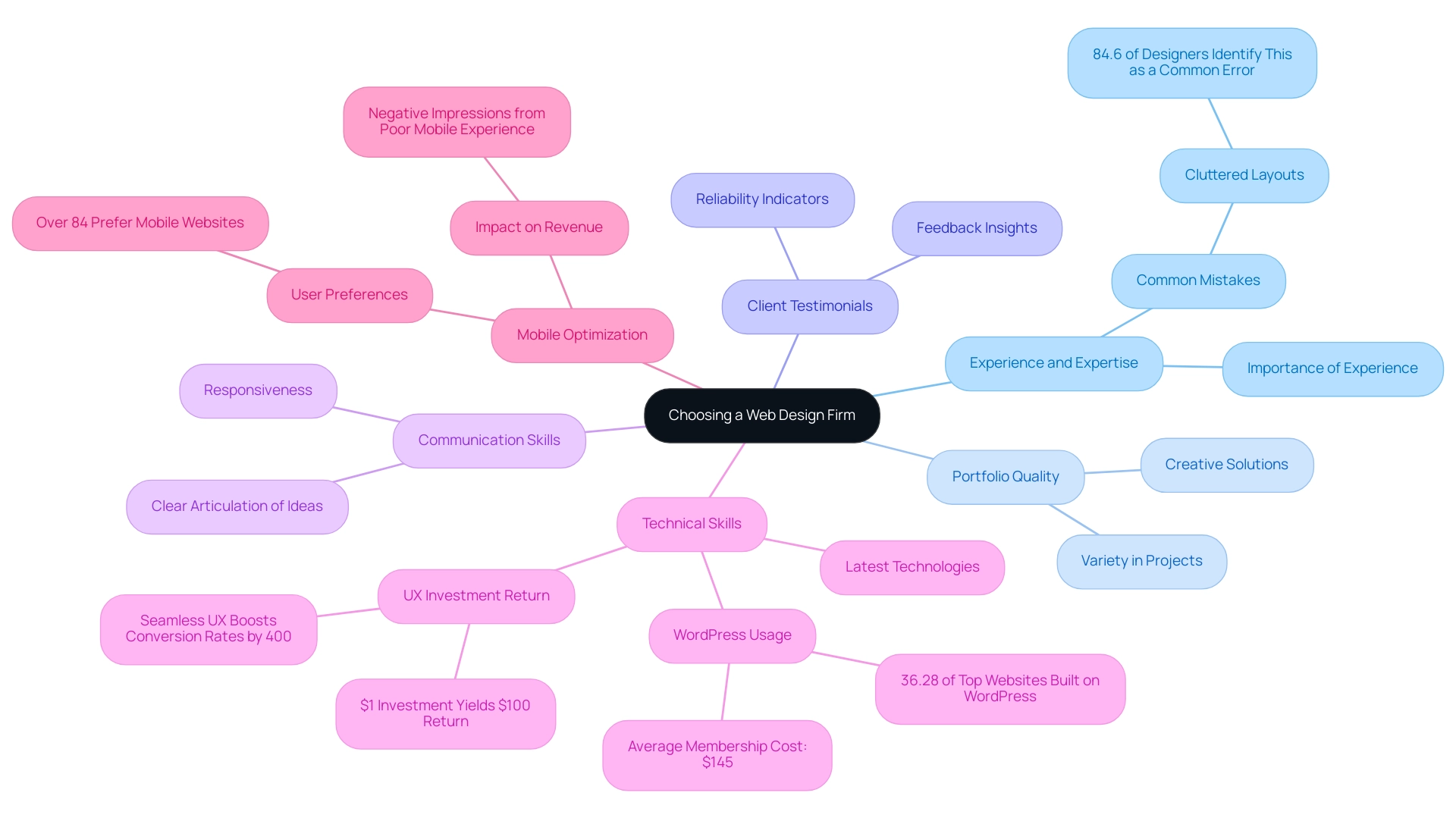
Common Services Provided by Web Design Agencies
Web designing firms typically offer a diverse array of services that cater to the unique needs of businesses aiming to establish a robust online presence. Key offerings include:
- Custom Website Creation: Personalized layouts that not only reflect your brand identity but also prioritize visitor needs, ensuring a seamless experience that resonates with guests. WonderEight excels in creating innovative designs that enhance brand identity and market presence.
- Responsive Design: With the increasing use of mobile devices, responsive design is crucial. It ensures that websites operate effectively across various devices, significantly improving experience and engagement. According to a detailed Forrester Research study, a seamless UX has the potential to boost your conversion rate by up to 400%.
- E-commerce Solutions: Agencies develop comprehensive online stores equipped with secure payment gateways and user-friendly interfaces, facilitating smooth transactions and customer satisfaction. WonderEight’s e-commerce development services ensure that your online store is not only functional but also strategically designed to drive sales.
- SEO Optimization: Effective strategies are implemented to improve website visibility on search engines, driving organic traffic and increasing the likelihood of conversions. WonderEight offers SEO consultancy to enhance your site’s performance in search rankings.
- Content Management Systems (CMS): Agencies often implement CMS solutions that empower clients to manage their website content effortlessly, allowing for timely updates and maintenance. WonderEight provides tailored CMS solutions that simplify content management for businesses.
- Social Media Strategy: WonderEight develops integrated social media strategies that enhance brand visibility and engagement across various platforms, ensuring that your online presence is cohesive and impactful.
- Digital Audits: Conducting thorough digital audits allows WonderEight to assess your current online performance and identify areas for improvement, ensuring that your digital strategy is data-driven and effective.
Understanding these services is essential for identifying which agency can best support your project. Notably, the significance of responsive layouts cannot be overstated; studies indicate that a seamless user experience can boost conversion rates by up to 400%. Furthermore, the most visited websites worldwide, like Google and YouTube, highlight the importance of effective web aesthetics in driving traffic. As demonstrated in comprehensive campaigns for brands like Miranda and Quaker Oats, engaging content and impactful brand experiences can significantly enhance overall market presence. As companies increasingly prioritize their online presence, choosing a web designing firm like WonderEight that excels in areas such as social media strategy and digital audits is vital for achieving lasting success.
Evaluating Portfolios: What to Look For
When evaluating a web creation agency’s portfolio, it is essential to consider several key factors that reflect their capabilities and alignment with your branding goals:
-
Diversity of Projects: A robust portfolio should showcase a variety of styles and industries, demonstrating the agency’s versatility. Statistics suggest that agencies with varied portfolios tend to attract a wider client base, as they can adjust their creations to satisfy different market requirements.
-
Quality of Presentation: Pay close attention to the aesthetics and functionality of the websites presented. Top-notch aesthetics not only attract individuals but also improve brand image. Look for projects that exemplify innovative creative principles and effective use of technology.
-
User Experience: Evaluate the navigability of the showcased sites. A seamless experience is paramount; research shows that a well-designed interface can significantly boost conversion rates. For instance, a study highlighted that a seamless UX could increase conversion rates by up to 400%, underscoring the importance of user-centric development. Moreover, data from the Resources section show a 73.30% increase in traffic through the navigation bar, further highlighting the effect of efficient layout on engagement.
-
Results Achieved: Examine case studies that describe the outcomes of the agency’s work. Noteworthy projects, such as the comprehensive campaigns created for brands like Miranda and Quaker Oats, demonstrate how effective creativity can lead to measurable success. These campaigns not only engaged audiences but also showcased the agency’s ability to deliver impactful branding solutions, resulting in significant brand recognition and customer engagement.
-
Optimization and Research: Consider the agency’s approach to audience research and experimentation. Tools such as VWO can assist in managing optimization programs, ensuring that the development process is guided by user insights and data-driven decisions.
By concentrating on these criteria, you can acquire a thorough understanding of a web designing firm’s strengths and evaluate if they align with your vision for a successful web presence. Moreover, WonderEight’s dedication to merging creativity with technology guarantees that their endeavors are not only visually striking but also strategically robust, positioning them as a formidable competitor in the web development arena.
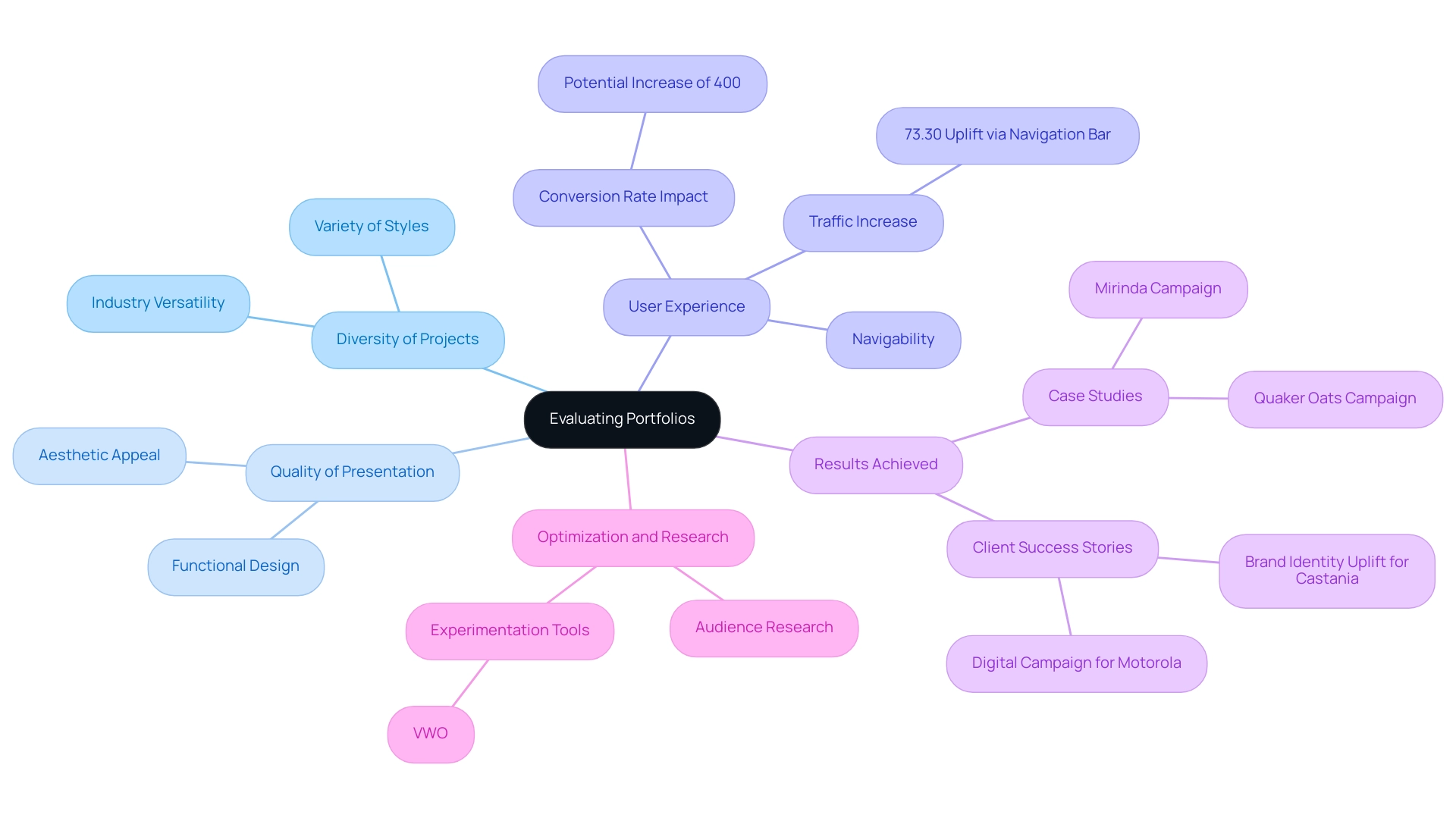
The Role of Client Testimonials in Your Decision-Making
Client testimonials are pivotal in the selection process for web design agencies, providing critical insights into several key areas:
- Agency Reliability: Feedback from former clients is a robust indicator of an agency’s dependability in meeting deadlines and budgets. Statistics reveal that agencies with positive testimonials often enjoy higher client retention rates, reinforcing their reliability in a competitive landscape. For instance, WonderEight has produced over 4,000 videos for 2,000 companies globally, including clients from diverse locations such as New York, Mumbai, and Paris. This showcases their extensive experience and unwavering commitment to quality work across various industries, from Technology to F&B and Retail.
- Quality of Work: Testimonials frequently highlight specific projects, showcasing the agency’s strengths and areas of expertise. For example, WonderEight’s comprehensive campaign for Quaker Oats not only elevated brand engagement but also demonstrated the agency’s capability to deliver impactful results, as evidenced by client feedback. This campaign led to increased consumer engagement and a more meaningful brand experience for Quaker Oats, illustrating how client testimonials can directly correlate with successful outcomes. A client noted, “WonderEight transformed our brand’s presence and engagement metrics significantly.”
- Customer Service: Positive reviews can illuminate the agency’s communication skills and responsiveness. Agencies that prioritize customer service typically receive higher ratings, which can significantly influence potential clients’ decisions when selecting a web design firm. WonderEight’s dedication to understanding the unique needs of each client ensures they deliver tailored marketing solutions that resonate with target audiences. Their ability to measure ROI and convey the right message through appropriate channels further underscores their strategic approach.
When evaluating testimonials, seek detailed feedback that addresses both the process and the final product. This comprehensive perspective will provide clearer expectations of the agency’s capabilities. Notably, incorporating testimonial videos on homepages can lead to substantial increases in conversion rates, with studies indicating that testimonials can enhance conversions on sales pages by as much as 34%.
This highlights the significance of client feedback in the decision-making process. Furthermore, strategically positioning testimonials can enhance web traffic and boost SEO, building trust and credibility with new users while reinforcing their purchase decisions.
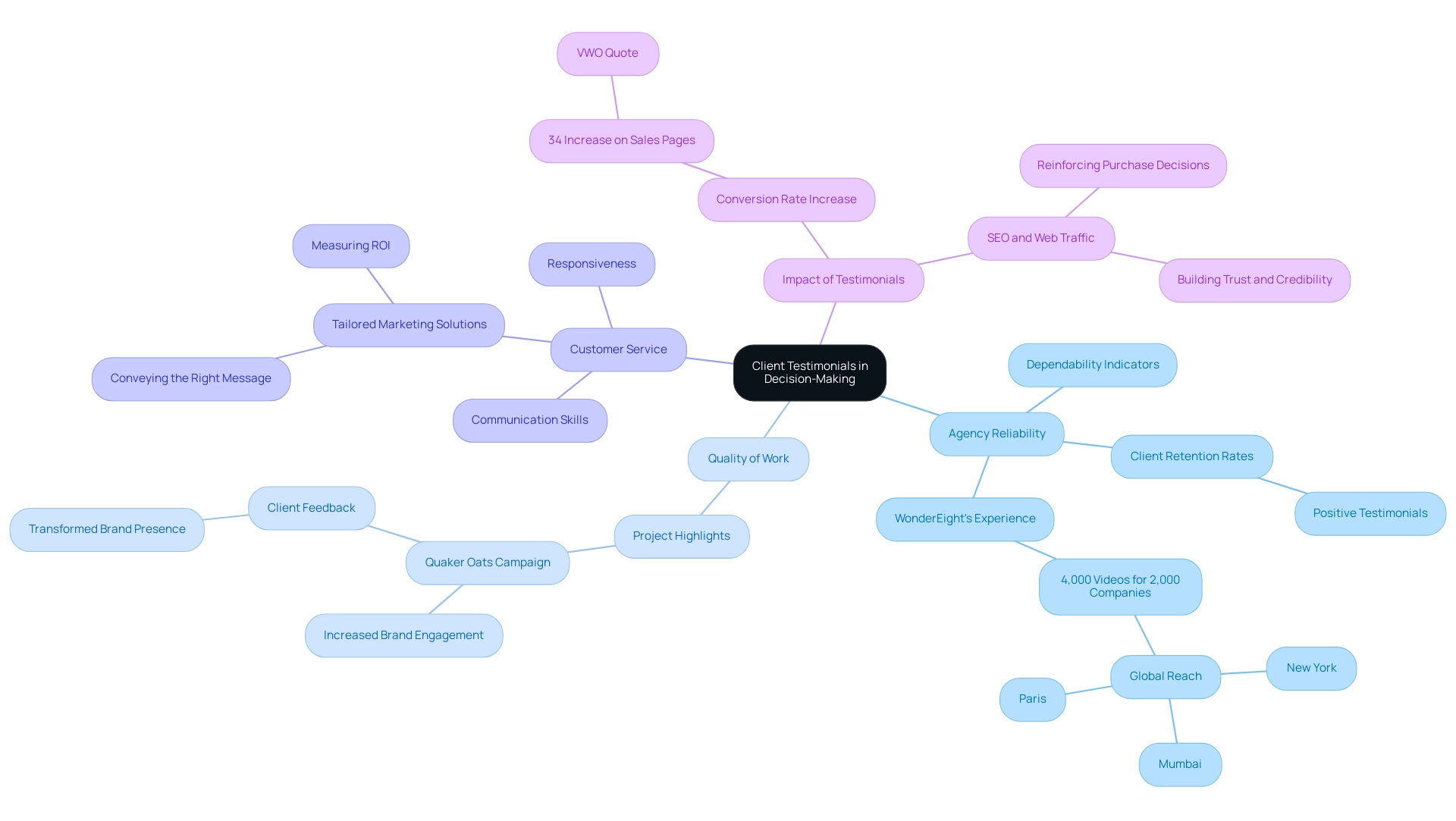
Effective Communication: A Key to Successful Web Design Projects
Effective communication is paramount throughout the web design process, profoundly influencing outcomes. Key components include:
- Setting Clear Expectations: Begin discussions about objectives, timelines, and deliverables from the outset. This proactive approach minimizes misunderstandings and aligns all parties with the initiative’s vision.
- Regular Updates: Establish open lines of communication to keep stakeholders informed about progress and potential challenges. Consistent updates foster transparency and trust, essential for a successful partnership.
- Feedback Loops: Encourage constructive feedback at various project stages. This iterative process ensures the layout aligns with your vision and allows for adjustments based on stakeholder input.
Statistics indicate that 50% of individuals believe a web design firm is crucial to a company’s brand image, underscoring the necessity of effective communication in achieving a visually appealing and user-friendly website. Furthermore, a survey reveals that 23% of small retail businesses in the US lack a website, highlighting the essential role of a web design firm in enhancing a brand’s online presence. Specialized roles in web development—such as back-end developers, front-end developers, and webmasters—each focus on different aspects of website construction and maintenance, making effective communication with these stakeholders vital.
Case studies, such as the brand identity uplift for Castania, illustrate how clear expectations and ongoing dialogue can yield measurable outcomes.
By prioritizing communication, you can enhance collaboration and ensure a smoother creation process, ultimately strengthening your brand’s online presence.
Budgeting for Web Design: Understanding Costs and Pricing Models
Budgeting for web design necessitates a comprehensive understanding of various pricing models, each of which can significantly influence overall costs:
-
Fixed Pricing: This model entails a predetermined fee for the entire project, offering cost predictability that simplifies budget management for businesses. However, it may lack the flexibility required for adjustments during the development process.
-
Hourly Rates: Charges in this model are based on the actual time spent on tasks. Hourly rates can vary considerably due to task complexity and team expertise. This approach proves advantageous for projects where the scope may evolve, allowing for necessary adjustments.
-
Retainer Agreements: These agreements provide ongoing support for a monthly fee, making them ideal for businesses that require continuous updates and maintenance. This model ensures that your website remains current and functional, which is crucial in today’s fast-paced digital environment.
When budgeting for web development, it is vital to consider not only the initial creation costs but also potential ongoing expenses for maintenance and updates. Ongoing maintenance and support costs can range from a few hundred to several thousand dollars per month, depending on the level of service required. Recent statistics indicate that website development expenses typically range from $1,000 to $1,500 at more than a third of agencies, with approximately 80.7% of tasks requiring about a month to complete.
Moreover, grasping the significance of website performance is essential in budgeting considerations. For instance, the average page speed of Google’s top 10 results is 1.65 seconds. According to Lyn Wildwood, a member of the Blogging Wizard content team, “the probability of bounce increases by 32% when a website’s page load speed increases from one second to three seconds.”
This underscores the necessity for companies to invest in efficient web development by partnering with a web design firm that not only fulfills aesthetic needs but also guarantees optimal performance.
Furthermore, leveraging AI tools in website creation can enhance budgeting and task management, improving overall efficiency. The expanding capabilities of AI in web development are making it increasingly accessible for businesses to collaborate with a web design firm to create professional websites. Understanding these elements will empower companies to make informed decisions and allocate resources effectively for their websites.
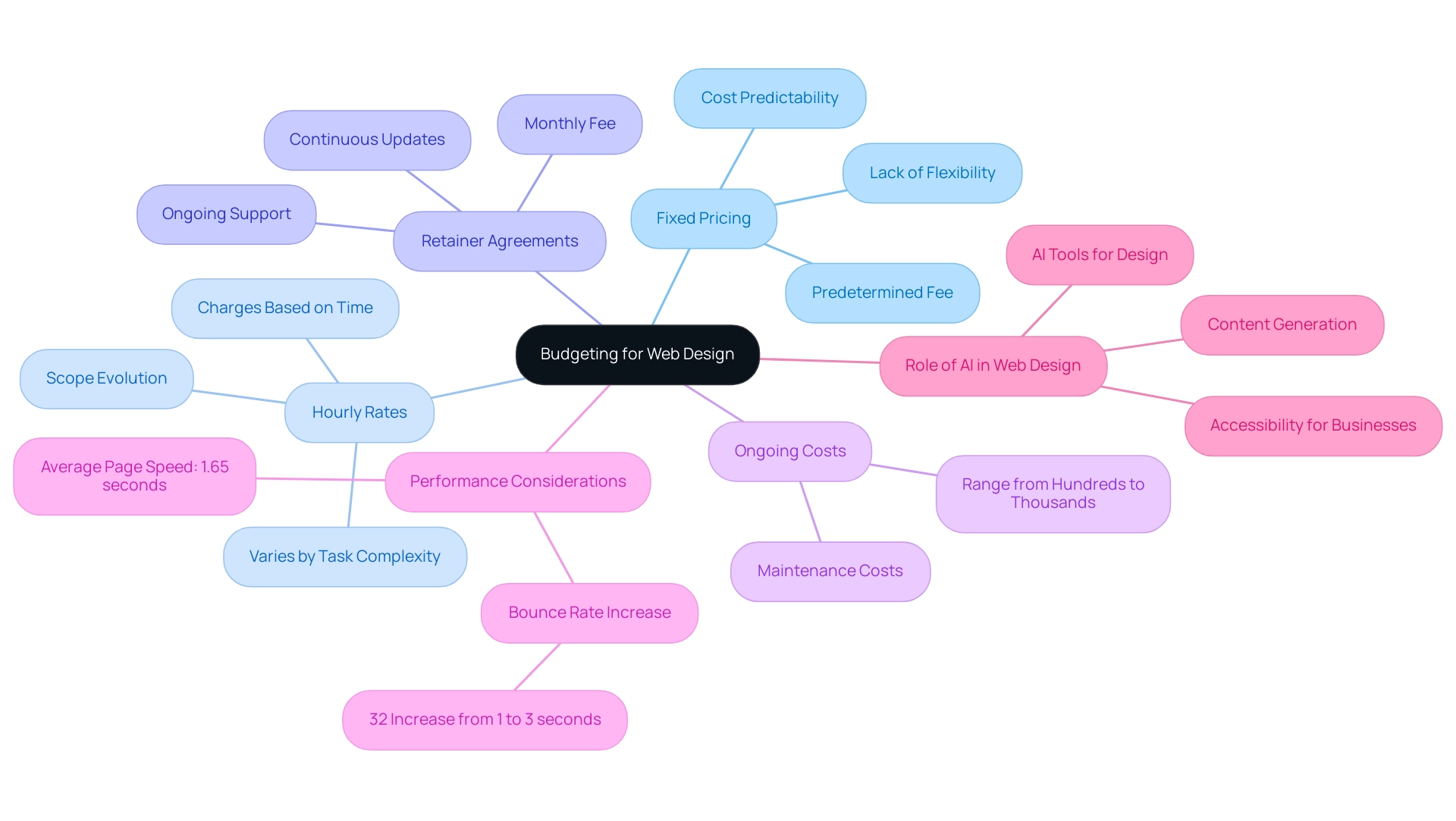
Next Steps After Choosing Your Web Design Partner
After selecting a web designing firm as your partner, adopting a structured approach is imperative for a successful collaboration. Here are the essential steps to take:
- Kick-off Meeting: Schedule an initial meeting to align on project goals, timelines, and expectations. This meeting is vital for fostering team unity and clarifying roles and deliverables, establishing a clear path for success. A well-structured kick-off minimizes confusion and enhances enthusiasm among team members, as evidenced by successful case studies. WonderEight’s unique approach to blending creativity with technology is exemplified in their kick-off meetings, which have led to successful outcomes for clients like Castania and Motorola.
- Contract Signing: Ensure that all terms are clearly outlined in a contract to protect both parties. This step is critical; statistics show that well-defined contracts can significantly reduce misunderstandings and disputes during the lifecycle. Michelle Symonds, a digital marketing consultant, emphasizes that “the individual with the responsibility for driving the initiative forward” is essential for maintaining clarity and focus, a principle that WonderEight adheres to in their management practices.
- Gather Necessary Materials: Provide the agency with any branding materials, content, and guidelines needed for the task. This preparation streamlines the design process and ensures that the agency has all the resources required to create a cohesive brand representation. WonderEight specializes in comprehensive branding solutions, ensuring that all materials align with the client’s vision.
- Establish Communication Channels: Set up regular check-ins to monitor progress and address any concerns. Consistent communication is key to maintaining alignment and adapting to any changes that may occur during the initiative. Utilizing the DACI framework, which categorizes team roles into Driver, Approver, Contributor, and Informed person/s, enhances clarity of communication and responsibilities. WonderEight emphasizes open communication as a cornerstone of their management strategy, ensuring that all stakeholders are informed and engaged.
By diligently following these steps, you can cultivate a productive working relationship with your web designing firm, ensuring that your project remains on track and meets your strategic objectives. WonderEight’s unique approach of blending creativity with technology further enhances the effectiveness of these structured processes, as demonstrated in successful projects for brands like Castania and Motorola.
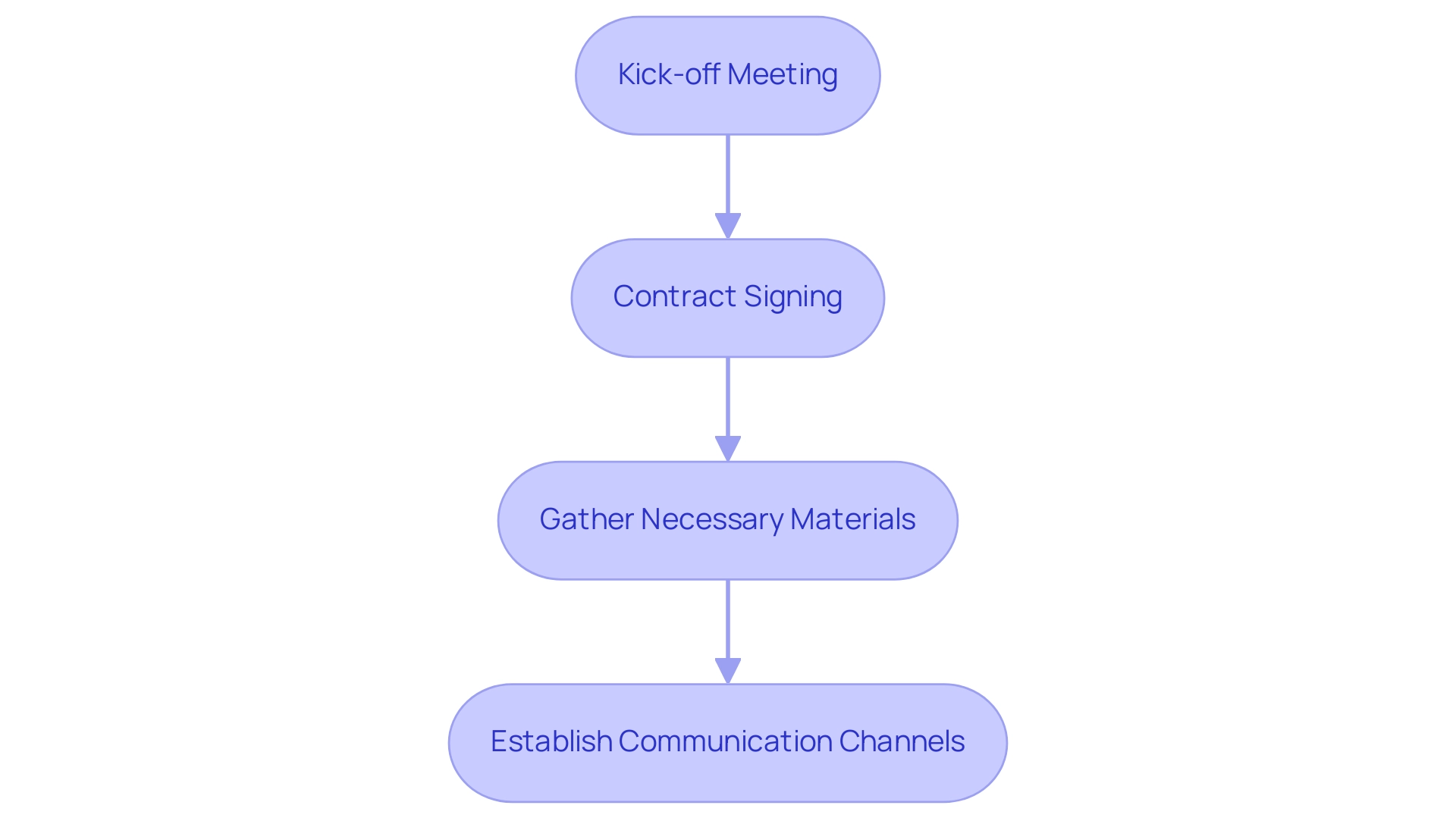
Conclusion
A compelling online presence is vital for businesses in today’s digital landscape. Understanding the essentials of web design is crucial for achieving this goal. This article has highlighted the fundamental elements of web design—layout, color schemes, typography, and navigation—all of which significantly impact user experience and brand perception. The importance of selecting the right web design partner cannot be overstated; factors such as experience, portfolio quality, and communication skills directly influence the success of web projects.
Moreover, the range of services offered by web design agencies—custom website design, responsive design, and SEO optimization—plays a pivotal role in establishing a strong online identity. Evaluating portfolios, considering client testimonials, and understanding the implications of effective communication are essential steps in making informed decisions. Budgeting for web design requires careful consideration of various pricing models to ensure that resources are allocated effectively.
Ultimately, choosing the right web design partner and understanding the intricacies of effective web design can lead to enhanced customer engagement and a lasting digital footprint. By prioritizing these elements, businesses can create visually appealing websites and foster meaningful connections with their audience, driving growth and success in an increasingly competitive market. Embracing these principles will pave the way for a powerful online presence that resonates with users and stands the test of time.
Frequently Asked Questions
What are the key components of web design that influence effectiveness?
The key components of web design include layout, color schemes, typography, and navigation. Each element plays a crucial role in enhancing user experience and accessibility.
How does layout affect a website’s performance?
Layout refers to the strategic arrangement of visual elements on a page, which can significantly influence user interactions. A well-organized layout can guide visitors through the site, improving engagement and user experience.
Why are color schemes important in web design?
Color schemes should align with brand identity and evoke the desired emotional response from visitors. Effective color choices can enhance brand recognition and engagement.
What role does typography play in web design?
Typography affects readability and audience engagement. Proper text style and appearance contribute to the website’s aesthetic appeal and influence how users perceive the brand.
Why is navigation crucial for a website?
Clear and intuitive navigation is essential for helping users explore the website easily. Efficient navigation enhances customer satisfaction and retention, which are vital for achieving business goals.
What impact does user experience (UX) have on conversion rates?
A seamless user experience can boost conversion rates by up to 400%, highlighting the importance of UX in web design.
What should businesses consider when selecting a web design firm?
Businesses should consider the firm’s experience and expertise, portfolio quality, client testimonials, communication skills, technical skills, and mobile optimization capabilities.
How can a web design firm’s portfolio help in the selection process?
A firm’s portfolio serves as an indicator of its creative style and capabilities. Varied projects and evidence of creative solutions can reflect the firm’s ability to meet diverse client needs.
Why are client testimonials valuable when choosing a web design firm?
Client testimonials provide insights into a firm’s reliability and client satisfaction, indicating their commitment to delivering results and maintaining strong relationships.
What is the significance of mobile optimization in web design?
With over 84% of visitors preferring mobile websites, neglecting mobile optimization can lead to negative user impressions and affect revenue and purchase decisions.
What financial benefits can come from investing in user experience (UX)?
For every dollar invested in UX, there is a potential return of $100, emphasizing the financial advantages of prioritizing user experience in website creation.



